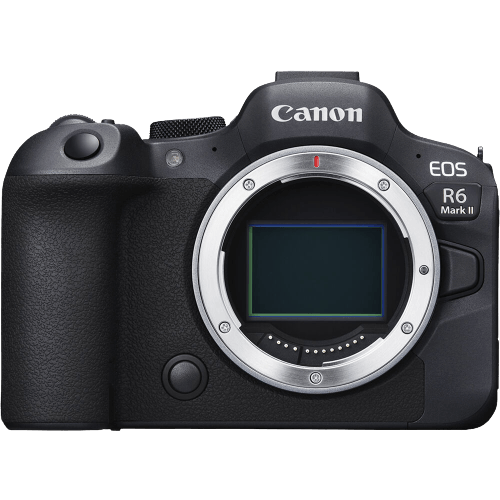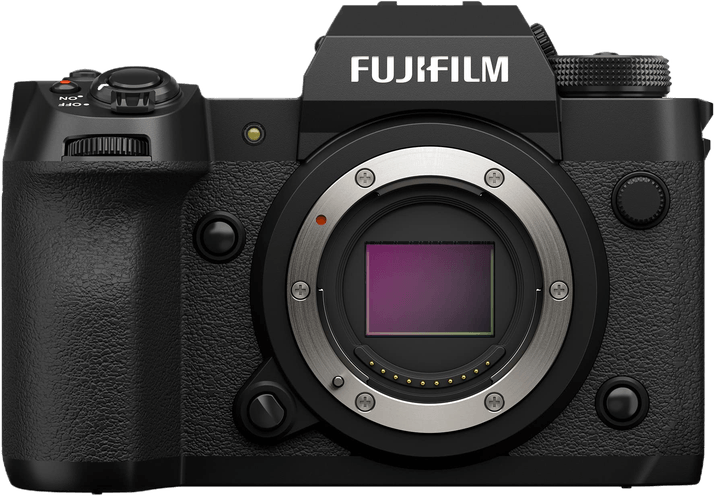Canon EOS R6 Mark II vs Fujifilm X-H2 Comparison
Canon EOS R6 Mark II

Fujifilm X-H2

The Fujifilm X-H2 takes the lead with a score of 82/100, while the Canon EOS R6 Mark II follows closely at 78/100. Both cameras are mirrorless and were released in 2022, sharing similar dimensions and announcement dates. The Fujifilm X-H2 excels with its lower launch price of $1999 compared to the Canon’s $2499. However, the Canon EOS R6 Mark II has the advantage of being lighter at 588g, as opposed to the Fujifilm’s 660g.
Taking these specifications into account, the Fujifilm X-H2 offers a more budget-friendly option without compromising quality. On the other hand, the Canon EOS R6 Mark II provides a lighter camera for those prioritizing portability. Ultimately, the final choice depends on the user’s preferences and priorities.
Canon EOS R6 Mark II vs Fujifilm X-H2 Overview and Optics
The Canon EOS R6 Mark II outperforms the Fujifilm X-H2 in optics, scoring 83/100 compared to the Fujifilm’s 81/100. Both cameras share several common specifications, such as CMOS sensor type, image stabilisation, and compatibility with their respective lens mounts. However, there are key differences that set them apart.
The Canon EOS R6 Mark II excels with its full-frame sensor size, Digic X processor, and 40 shooting speed, which surpasses the Fujifilm X-H2’s APS-C sensor size, X-Processor 5, and 15 shooting speed. The larger sensor and faster processor allow the Canon EOS R6 Mark II to capture more detail and perform better in low-light conditions. Additionally, the Canon’s superior shooting speed ensures capturing fast-moving subjects with ease.
On the other hand, the Fujifilm X-H2 boasts a higher megapixel count of 40 compared to Canon’s 24. This higher resolution allows for more detailed images and greater cropping flexibility. However, the Fujifilm’s DXOMARK score for the sensor is not available, making it difficult to compare the overall sensor performance directly.
Despite the Fujifilm X-H2’s advantage in resolution, the Canon EOS R6 Mark II’s full-frame sensor, faster shooting speed, and advanced processor contribute to its higher optics score. The Fujifilm X-H2 still has its merits, particularly for those seeking higher resolution images. Ultimately, the choice between these two cameras will depend on the photographer’s priorities and preferences.
Canon EOS R6 Mark II vs Fujifilm X-H2 Video Performance
The Canon EOS R6 Mark II and the Fujifilm X-H2 both have a high video score, with the Fujifilm taking the lead with it’s maximum video resolution of 8K and video dimensions of 3840 x 2160.
Both cameras have their respective strengths and weaknesses in video performance. he Fujifilm X-H2 offers better color science, resulting in more accurate and vibrant colors in the video output. This allows users to spend less time editing and color grading their footage. The Fujifilm X-H2 also has a more compact and lightweight design, making it a more portable option for videographers who need to travel or shoot on location frequently.
The Canon EOS R6 Mark II excels in its user-friendly interface, making it easier for users to navigate and adjust settings during video recording. Additionally, the Canon EOS R6 Mark II boasts a more extensive range of native lenses, providing videographers with greater flexibility and creative options when capturing footage.
Both cameras have their respective strengths and weaknesses in video performance. he Fujifilm X-H2 offers better color science, resulting in more accurate and vibrant colors in the video output. This allows users to spend less time editing and color grading their footage. The Fujifilm X-H2 also has a more compact and lightweight design, making it a more portable option for videographers who need to travel or shoot on location frequently.
Canon EOS R6 Mark II vs Fujifilm X-H2 Features and Benefits
The Fujifilm X-H2 wins in the features comparison with a score of 85/100, while the Canon EOS R6 Mark II scores 72/100. Both cameras share several specifications, including a 3-inch touchscreen with a resolution of 1620000 dots, flip screen, WIFI, and Bluetooth connectivity.
The Fujifilm X-H2 outperforms the Canon EOS R6 Mark II in terms of features, mainly due to the presence of GPS. The GPS functionality allows photographers to geotag their images, which is beneficial for professionals and enthusiasts who need accurate location data for their work. This added functionality gives the X-H2 an edge over the R6 Mark II.
On the other hand, the Canon EOS R6 Mark II does not have any specific features that make it better than the Fujifilm X-H2. Both cameras have similar screen capabilities, connectivity options, and user-friendly interfaces. The lack of GPS in the R6 Mark II puts it at a disadvantage compared to the X-H2.
Considering the individual strengths and weaknesses of the cameras, the Fujifilm X-H2’s GPS functionality gives it an advantage over the Canon EOS R6 Mark II. Photographers seeking accurate location data for their images will find the X-H2 more suitable for their needs. However, both cameras offer excellent features, and users who do not require GPS functionality may still find the Canon EOS R6 Mark II a worthy contender in the market.
Canon EOS R6 Mark II vs Fujifilm X-H2 Storage and Battery
The Fujifilm X-H2 takes the lead in storage and battery with a score of 79/100, while the Canon EOS R6 Mark II scores 11 points lower at 68/100. Both cameras share common specifications, such as having two memory card slots and USB charging capabilities. The Fujifilm X-H2 accepts CFexpress Type B and SD (UHS-II Compatible) memory cards, whereas the Canon EOS R6 Mark II is compatible with SD, SDHC, and SDXC (UHS-II compatible) memory cards.
The Fujifilm X-H2 outperforms the Canon EOS R6 Mark II in battery life, offering 680 shots per charge, compared to the Canon’s 360 shots. This extended battery life makes the Fujifilm X-H2 more suitable for extended shooting sessions. On the other hand, the Canon EOS R6 Mark II provides a wider range of memory card compatibility, which may be advantageous for photographers with existing memory card collections.
Considering these factors, the Fujifilm X-H2’s superior battery life makes it a better choice for photographers who require extended shooting capabilities. However, the Canon EOS R6 Mark II’s broader memory card compatibility offers flexibility for users with varied memory card preferences.
Canon EOS R6 Mark II vs Fujifilm X-H2 – Our Verdict
Are you still undecided about which camera is right for you? Have a look at these popular comparisons that feature the Canon EOS R6 Mark II or the Fujifilm X-H2:

